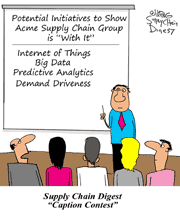 |
August 8, 2014 - Supply Chain Flagship Newsletter |
 |
| SPONSOR: NORTHWESTERN UNIVERSITY |
||
 |
||
Online Learning – Master of Science in Predictive Analytics |
||
| At the Forefront of Business Intelligence |
||
 |
||
 |
|
||||||||||||||||||||||||||||||||||||||||||||||||||||||||||||||||||||||||||||||||||
Getting Planning in the Supply Chain Right
|
|||||||||||||||||||||||||||||||||||||||||||||||||||||||||||||||||||||||||||||||||||
| GILMORE SAYS: |
"Planning, it is clear, is a leadership activity." WHAT DO YOU SAY? |
"The plan is garbage. Don't tell me the plan. Tell me what we want to happen, what will keep us from making it, and what are we going to do to make sure we make it!"
Between military leaders (Sun Tzu, Alexander, Napoleon, Von Moltke, Eisenhower and others), there is no lack of quotes about how important the planning exercise is. We often see these pithy quotes at the start of business articles, the author hoping the reader's recognition of the name associated with the quote legitimizes yet again another article written by somebody who writes for a living.
Nobody famous or important uttered the words that start this article. I said them in a meeting last week with a client. I'm not famous. I don't write articles in the trade press for a living. I coach people wanting to become effective in the planning and execution of their business. When I do write, like this article, the effort is to teach people to think differently.
I believe supply chain and logistics leaders need to rethink their approach to planning. In summary, the problem with planning in many supply chains can be broken into two parts:
First, the planning process insufficiently identifies risks. It is common to see ignored communications gaps, or lapses in timing errors that don't show up in summary data. These are issues like the trailer not making the gate at the intermodal hub and waiting a few days for the next train.
The second problem comes when the plan that evolves is too rigid and inflexible to adapt to the unexpected events. The trailer missed the train, so it arrived 2 days later than planned, and missed the distribution date. These two problems become a "One-two" punch that frustrates planners in every company.
Planning, not the Plan
There is a huge difference between the act of planning and the apparent product of that effort, the Plan. The Plan for the most part is a wishful dream, how in the best conditions we dream how events will unfold. The Plan assumes things will happen that never will, and ignores things that surely will happen. The Plan depends on committed support of people who have no apparent reason to lend support and ignores the real stakeholders.
However, all of that development of the Plan assumes that people actually engage in the effort of developing a plan. The assumption is faulty. Most supply chain functions and managers do not really plan.
Most groups fail to even plan and organize the smallest of projects. Here is an example of one of the little exercises I use with my client groups to measure if leadership and planning DNA exists in the organization.
The Binder Test
 We all have probably attended workshops where there is a binder of session materials. Most times, the organizer hands out a prepared binder with dividers, indexed tabs, and the workshop materials.
We all have probably attended workshops where there is a binder of session materials. Most times, the organizer hands out a prepared binder with dividers, indexed tabs, and the workshop materials.
Working with companies, I don't do that. We make the group assemble their own workshop binders. We pile all of the supplies, binders, dividers, pre-printed index tabs, and the filler material into the middle of the table. One complete version of a finished binder sits next to the supplies. At the start of the meeting, I tell the group that everything they need to make their binders is on the table, and give them 5 minutes to make their books.
In the past 5 years of doing this, only two groups actually got the binders completed in less than 10 minutes. Most groups take about 20 minutes, and there are stragglers. Some individuals will take the example binder, quietly figure out what to do, and then execute their own binder. Sometimes the self-reliant people help the rest of the crowd. However, seldom will somebody take charge, figure out what needs to happen, and then lead the group to finish.
Look at your circle of influence and ask this question: "Could we pass the Binder Test?"
Successful planning requires leadership. Somebody must step up and start leading the group to organize and plan. The successful examples of my exercises always have someone that takes action first, communicating what they are doing along the way, leading the rest of the group along the path.
Planning, it is clear, is a leadership activity.
The level of planning that I see in both supply chains and the overall business today often astounds me. Leadership does not appear to care or understand. What passes as planning in so many companies is so ineffective that I don't need to wonder how the client failed to accomplish their objective. Failures happen not because of the skills or abilities of the people to do the job, failure comes from an absence of active leadership and the planning they didn't do.
Just putting a list of actions together on a sheet of paper is not a plan; it is just a list of tasks. You must ask and answer leadership questions: Are these the right tasks to do? Are these tasks in the right order? Are the right people doing these tasks? Are these tasks going to get us to the objective?
The biggest leadership questions of all, you must ask: Are we working to the right objective?
Tell me What We want to Happen
What is the desired outcome? This seems like such as obvious place to start, yet most just skip past it, assuming that we know what we want to accomplish. It is a question so obvious that we don't take the time to really define it, assuming that everyone should instantly understand the context and the meaning of the objective. The objectives are so obvious that our plans just say "Install Software", "Install Racks", or "Deliver Package". In an effort to be brief, or just being lazy, we consider the objective so obvious that we fail the format and most critical step - defining what we want as the outcome.
What do I mean by the outcome? Here are some very basic examples:
Instead of "Install Software Update", we use:
Install the software between the hours of 2 AM and 4 AM, including all configuration settings, file pointers and user permission files. Test to assure that the application launches and that it opens and closes all production files across the network. The installation must be completed, tested, and the production system available for the operations to start using no later than 5:15 AM.
Instead of "Install Racks", we use:
Install the pallet racks to the specifications on the drawings. Assure all beam locking pins seat. Sweep all anchor dust and wipe concrete dust off the posts. Shim the uprights so the posts are plumb to less than one-quarter inch over 10 feet in both transverse and lateral directions. Complete each double row, including anchors and tightening all hardware, before moving to the next double row. Update progress on the project drawings as each double row is complete and ready for use. Complete a minimum of four double rows per day. Do not start a double row unless it will be finished that day.
What makes these outcomes better than "Install Software Update" or "Install Racks"? It's in the details, the kind of details that define the quality of the outcome, the "how I want it", the "when I want it", and the "what I want".
Defining the outcome with this kind of detail increases the value of the outcome, and is a first big step towards creating a successful plan. Well-defined outcomes go beyond the so obvious trap that many managers fall for. Defining the details of the outcome is an act of leadership assuring successful planning.
Well, as is often the case with Dan, I am out of space. With his Ok, we will conclude these thoughts on better planning next week with a look at managing risks to the plan.
Do you agree many companies do not do planning effectively? Why or why not? Let us know your thoughts at the Feedback section below.
![]()
| View Web/Printable Version of this Column |
|
|
|
YOUR FEEDBACK
We received a few nice letters on our recent First Thoughts piece on Insights from Unilever's Perfect Logistics Network Exercise, but frankly not as many as we expected given how innovative this program was. Please send in your thoughts on our articles.
Below you will find our feedback of the week on this topic, from David Armstrong of Inventory Curve, as well as a few others.
Feedback on the Week on Unilever Perfect Logistics Network:
1) Reaction to Unilever's perfect network exercise Based on the article, Unilever US has done an excellent job narrowing down and defining opportunities. While it tends to support the 80/20 factoid that you started with, it is important to recognize the opportunities are both short term and long term. Locking in a network tends to lock in things as they are at the time, but the environment is dynamic. Things are always changing, so it is entirely possible the network decisions made in the past were the right ones to do at that time and now they don't match the current environment.
So there really are two opportunities to work on moving forward: operational and network design. And it does not surprise me at all that when Unilever applies this approach in other geographies, that they find significant differences. 2) Unilever's recent corporate performance I looked at Unilever's corporate financials, not just in the US, and found some nice improvements over the past three years. Gross margin is up to 41.3% from 39.9% and distribution costs as a percentage of Sales and Administrative expenses have declined from 25.4% to 24.0%. Inventory turnover increased from 6.3 to 7.0. As a result, GMROI (Gross Margin Return on Inventory Investment) improved from 4.18 to 4.93. And they have a current cash to cash cycle of negative 59.7 days. David Armstrong
|
||
| More on Unilever Network: | ||
This is really quite innovative, and something I am surprised either hadn't been invented before, or of it has, become more broadly understood used. Being in the CPG industry ourselves, you can trust your column generated quite a bit of discussion around the proverbial watercooler the next day - we are already looking at how we might begin such a program. Keep up the good work!
Director of Logistics Name witheld by request |
||
Love the article on Unilever's pursuit of the perfect network! We are embarking on a very similar quest, and using Llamasoft as our network design tool. Would love to chat about this quest, plus see if you think it would be worth a chat with Unilever to get some "lessons learned."
VP of Transportation Name witheld by request Editor's Note: As is almost always the case, SCDigest editor Dan Gilmore is pleased to help in this case.
|
||
This is really good idea - wish I would have thought of it first. The key of course is how you can really breakdown or segment as you said the different cost buckets after you determine the perfect logistics network costs - the latter would seen to me the easy part if you had a good tool. But identifying and segmenting the other costs to reach the 100% of actual spend - that seems really difficult,. Would love to understand more how that was done. Can SCDigest do some follow up? You also do a masterful job taking a complex topic and making it understandable for readers- keep up the great work! Todd Bunning Carlsbad, CA
|
SUPPLY CHAIN TRIVIA ANSWER
Q: What supply chain related metric is calculated as: Receivable Days + Inventory Days - Payable Days?
A: The cash to cash cycle.
| © SupplyChainDigest™ 2003-2014. All Rights Reserved. SupplyChainDigest PO Box 714 Springboro, Ohio 45066 |
POWERED BY: XDIMENSION
|








